FORMATIONS: Selected Works by Francis Almendárez, 2013-2025
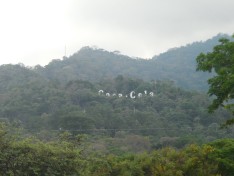
Voices of Our Mothers: Transcending Time and Distance (2016)
Los Angeles Filmforum presents
FORMATIONS: Selected Works by Francis Almendárez, 2013-2025
Sunday May 4, 2025, 7:00pm
At 2220 Arts + Archives, 2220 Beverly Blvd., Los Angeles CA 90057
In person: Artist Francis Almendárez & Programmer Diego Robles
Including the World Theatrical Premieres of six videos - Voices of Our Mothers, Dinner as I Remember, rhythm and (p)leisure, (be)coming home, Navigating the Archives Within, and Denim Terrains!
Please note earlier start time.
Tickets: $15 general, $10 students/seniors, free for Filmforum members
https://link.dice.fm/j7b6dbfb05fa
These selected works by Francis Almendárez delve into the everyday in distinct ways, displaying a Los Angeles hardly ever seen. Intimate and personal, yet abstract and poetic - Almendárez toggles between showing us reflections of his lived reality, and embodying the images and sounds of the lived reality as it is shown.
FORMATIONS broadly defined brings these works into conversation with the recent past, and our current time. The compiled videos together broadly outline the ways Almendárez has delved into moving images, the world of soundscapes, and ontological interpretation. Like jazz sketched musically by an ekphrastic poem, Francis sketches moments in life that connect to larger patterns of thought and feeling.
As each of these videos was completed, they were gradually exhibited outside California, in mostly small DIY circles, classrooms, or art gallery installation settings. Never before screened in California, and ever screened theatrically anywhere in the world, all six videos will have their World Theatrical Premieres. These videos together ask us to link our private thinking with our environment around us.
FORMATIONS refers to both great landscapes traversed physically, and the significant experiences that come along with our upbringing and growth. In Latin-America there’s a question one can ask of another when inquiring about their life trajectory - ‘Como te formaste?’. In the case of artists, it can open discussion about their way of being and aesthetic development , and while the question doesn’t translate smoothly into English (i.e. 'How did you train?'), in Spanish - especially in a Latin-American context - it simultaneously can be about one’s personal and familial cultivation, one’s intellectual influences, one’s artistic development, one’s moral and ethical instincts, and one’s own integral and truthful reach toward maximum potential. Often, such a question is within a backdrop that has already acknowledged great adversity and obstacles one has lived through, and if nothing else, the question usually is reinforcing the drive and consistency one recognizes in the other. This kaleidoscope of multiple meanings that Almendárez's documentation and videos bring, serve to playfully reflect on Los Angeles, its textures, tones, and colors that float amongst the escapist narratives, planned obsolescence, and resiliency of its inhabitants.
Francis Almendárez will be with us in person to discuss the films further.
Notes and Program by Diego Robles.
Francis Almendárez is an artist, filmmaker, and educator from South Central, Los Angeles. His work takes many different forms including exhibitions, screenings, performances, workshops, and collaborations that have been presented across museum, university, and DIY spaces both nationally and internationally. Through the merging of history, autoethnography, and cultural production, his works offer ways to navigate and reconcile with intergenerational trauma and reclaim diasporic identities. Recent presentations include screenings at Miami New Media Festival and Cité Internationale des Arts, Paris; DIY photography and filmmaking workshops in Honduras and El Salvador; public photo-murals at FotoFest, Houston; and collaborative performances at Antenna, New Orleans and Prospect Art, Los Angeles. Almendárez is an Assistant Professor of Photography/Video and Studio Art at California State University San Bernardino, and previously lectured at University of Houston School of Art and Houston Community College. He received his MFA (with Distinction) from Goldsmiths, University of London, and BFA in Sculpture/New Genres from Otis College of Art and Design. www.francisalmendarez.com
Diego Robles is an educator, artist, filmmaker, programmer and curator. Inspired by independent film, video stores, public libraries, comics, and a lot of live and recorded music, he's a Film School graduate of the UCLA School of Theater, Film, and Television, as well as an MFA graduate of CalArts's School of Film/Video & the School of Critical Studies. Robles currently teaches Art Education History, Theory, and Practice, as well as internships for Art & Design at San Diego State University. He also teaches New Genres, Creativity, Imagination & Consciousness, Visual Studies, Art & Community, Art Writing, and Chicanx Art at CSU San Bernardino. His current visual and media artwork inquiries into the philosophical underpinnings of how we interpret our inner and outer world during different points in our lives, and the impact this has on how our human and non-human relationships evolve/adapt/struggle through our changing economic, environmental, political, and social-cultural climate.

Mountain
Mountain
2013 | USA | Digital Video | Color | Sound | 2:11 min.
Mountain plays with perspective, scale, time and sound to create a sense of anxiety and (both spatial and temporal) displacement. Confronting the viewer with the appearance of nothing happening - with stasis - the work utilizes waiting or being idle to gain insight and a deeper sense of time, duration and what it means to be 'productive.' The work thus steps on this threshold between being 'productive' and 'unproductive' and attempts to see how far anticipation and expectation could be pushed and/or stretched.
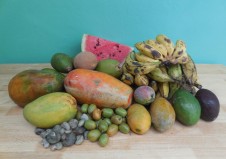
Dinner as I remember
Dinner as I Remember
2016 | USA | Digital Video | Color | Sound | 3:14 min.
World Theatrical Premiere!
In Dinner as I remember, a voiceover narrative recalling the period of time leading up to dinner during childhood is superimposed with a slideshow of images of typical dishes eaten in Central America and the Caribbean. The images are mostly shot candidly as commonly seen on social media: some really close up while others set further back, enough to show family members sharing a meal. The title and the tone in the voiceover imply a longing for those foods and of familial/cultural belonging, while also re-framing those intimate moments and family dynamics at the dinner table as parts of larger concerns. The viewer is essentially taken on a journey re-thinking the concept of “family dinner” or “dinner at a table” as a communal/sacred tradition and acknowledging how the foods we eat, as ordinary as they may seem, are layered with histories, cultures, and politics of their own.
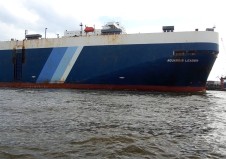
Voices of Our Mothers: Transcending Time and Distance
Voices of Our Mothers: Transcending Time and Distance
2016 | USA | Digital Video | Color | Sound | 17:49 min.
World Theatrical Premiere!
I.When I sing, I remember
II.Lessons my grandmother taught me
III.Time and meter are in rhythm but rhythm has no time
Paul Gilroy argues that memories of slavery are manifest (through their metaphorical displacement by lyrics of lost love) in current Black music. Lost love itself is thus the key metaphor in Black popular culture’s commentary on the failed promises of ‘modernity.’
Through a set of vignettes inspired by Gilroy, Voices of our Mothers: Transcending Time and Distance shows how song, oral history, dance and improvisation function as archival and living forms of history.
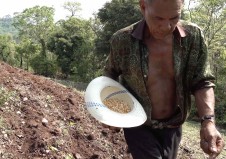
rhythm and (p)leisure
rhythm and (p)leisure
2014/2019 | USA | Digital Video | Color | Sound | 36:33 min.
The work retraces the artist’s familial paths of migration in Central America; from El Salvador to Honduras and Nicaragua, and eventually the United States. This work examines the notion of "productivity" and how the meaning of that word changes depending on how the body is racialized or gendered, and what task that body is performing. Numerous video portraits of both family and community members performing various tasks of labor are placed side by side, prompting the questions: what bodies are afforded leisure?, and is it possible to reclaim ownership of one's own body? There is no dialogue but instead a visual and aural tour of working-class labor that speeds up to follow a transition from the countryside to the city. Using piles of discarded clothes and wooden pallets for their corporeal properties and associations to the working-class, the installation alludes to the global circulation of people and communities offering up their bodies and labor – and by extension – the circulation of culture(s) and how it is consumed, appropriated, repackaged, and resold. In elevating the value of “unskilled” and reproductive labor, the work ultimately challenges prevailing negative depictions of immigrant and working-class communities, while blurring the line between work and leisure.

(be)coming home
(be)coming home
2019 | USA | Digital Video | Color | Sound | 3:48 min.
World Theatrical Premiere!
Reusing photographs originally shot on film in 2010 (post-financial crisis), they were scanned and compiled into a slideshow with digital photographs shot in the same style in 2019. The former showcase the façades of homes in my former South Los Angeles neighborhood as well as commercial structures in various stages of disrepair alongside the adjacent decommissioned BNSF railway. The latter showcase similar Black & Brown neighborhoods in East and Southeast Houston currently facing gentrification and that remind me of my former home in Los Angeles. This new sequence of photographs is superimposed with a voiceover dialogue that re-frames these architectural structures and their materiality as ephemeral embodiments of histories and cultures. This could be seen as a metaphor for the laborious and aging human body, and particularly our impermanent, precarious, and contingent relationship to and with land. While contemplating notions of home, migration, and belonging, the work questions the constructs of human ownership and dominance over land. It ultimately propagates the notion of home as extending beyond any physical container and instead as a composite of connections and interconnections between people, communities, and the spaces they share.
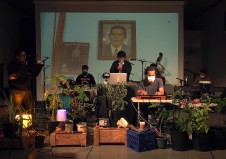
Navigating the Archives Within
Navigating the Archives Within
2020 | USA | Digital Video | Color | Sound | 36:00 min.
World Theatrical Premiere!
Navigating the Archives Within questions how histories, cultural traditions, and personal experiences are kept and transmitted. Incorporating original and archival imagery with live readings and improvised music, the experimental performance explores distinctions between “official” narratives, marginalized histories, and subjective memories while it blends and remixes them. Filmed live at Aurora Picture Show’s space and streamed free for five days on their website, the 36-minute video captures an autoethnographic journey through Latinx misrepresentation, erasure, subordination, and subversion. Collaborations by: Anthony Almendarez (Trumpet & Electronics), Abel Cisneros (Keyboard), Sonia Flores (Bass), Xavier Gilmore (Electronics & Percussion), and Gabriel Martinez (Drums)
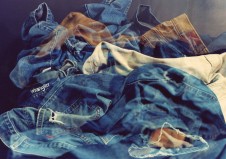
Denim Terrains
Denim Terrains
2025 | USA | Digital Video | Color | Sound | 3:00 min.
World Theatrical Premiere!
Denim Terrains comes out of a larger body of photographic work titled Denim (Worker Pants) that interrogates notions of value by using as a point of departure techniques and aesthetics typically reserved for studio portraiture and product photography. Together they highlight how image-based media produces, assigns, and props up value that is inherently arbitrary and/or autocratic. In that same vein, the photographs for this particular film were specifically made using expired film and positive slide film that was cross-processed as negative film to really exaggerate and experiment with color, and break away from traditional photography.
In scanning and (re)photographing the results, these materials were transmuted and composited into new digital configurations. Collaged, overlayed, and abstracted, both the photographs and the topographic maps of the artist's eyes illustrate how the different stages of wear and tear register the movement and aging of the body. In addition to referencing the body and mountainous terrains in Central America and Southern California, using the denim as a material offers us ways to draw parallels and connections between body as territory and territory as land.
